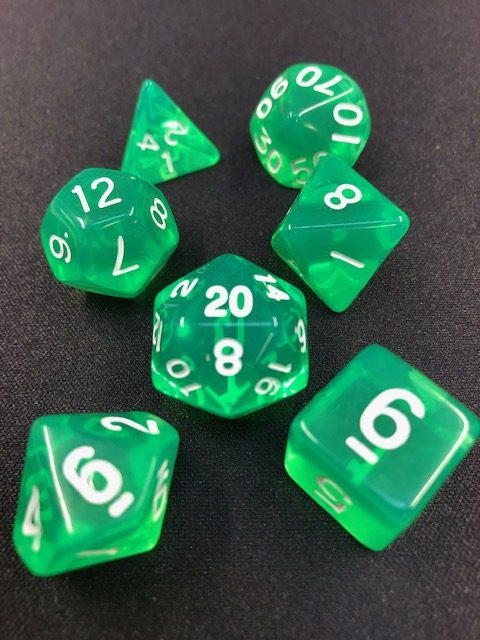Description
Polyhedral Set of Dice: (Source is Wikipedia for descriptions, which I found kinda cool!)
This Purchase will get you / contains –
7x Gem Dice (Transparent appearance) – Green (See Image)
This includes:
1 D4 (Tetrahedron) – Each face has three numbers, arranged such that the upright number, placed either near the vertex or near the opposite edge, is the same on all three visible faces. The upright numbers represent the value of the roll. This die does not roll well and thus it is usually thrown into the air instead.
1 D6 (Cube) – A common die for many games. The sum of the numbers on opposite faces is 7.
1x D8 (Octahedron) – Each face is triangular and the die resembles two square pyramids attached base-to-base. Usually, the sum of the opposite faces is 9.
1x D10 (Pentagonal Trapezohedron) – Each face is a kite. The die has two sharp corners, where five kites meet, and ten blunter corners, where three kites meet. The ten faces bear numbers from zero to nine, rather than one to ten (zero being read as “ten” in many applications). Often all odd numbered faces converge at one sharp corner, and the even ones at the other. The sum of the numbers on opposite faces is usually 9 (if numbered 0–9) or 11 (if numbered 1–10).
1x D10 Percentile (Pentagonal Trapezohedron) – Each face is a kite. The die has two sharp corners, where five kites meet, and ten blunter corners, where three kites meet. The ten faces bear numbers with 10, 20, 30, 40, 50, 60, 70. 80, 90 and 00 rather than one to ten, or zero to nine.
1x D12 (Dodecahedron) – Each face is a regular pentagon. The sum of the numbers on opposite faces is usually 13.
1x D20 (Icosahedron) – Faces are equilateral triangles. Icosahedra have been found dating to Roman/Ptolemaic times, but it is not known if they were used as gaming dice. Modern dice with 20 sides are sometimes numbered 0–9 twice as an alternative to 10-sided dice. The sum of the numbers on opposite faces is 21 if numbered 1–20.

